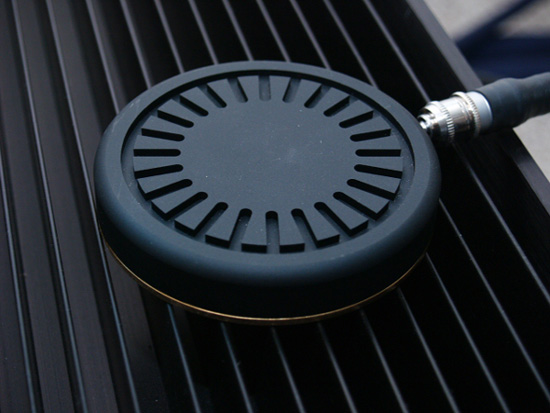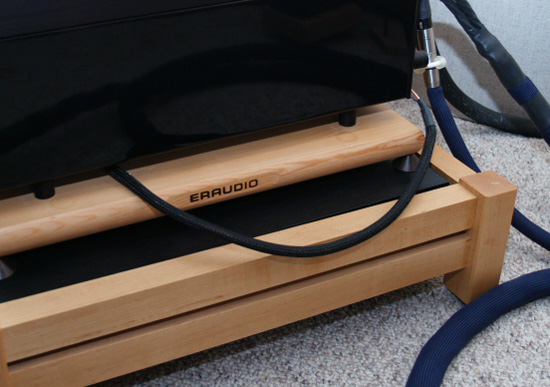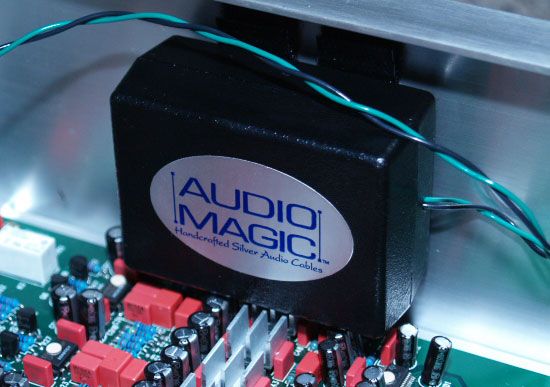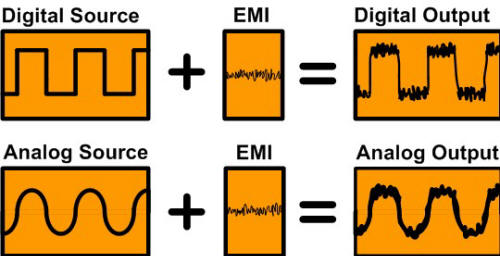You are reading the older HTML site
Positive Feedback ISSUE
november/december 2007
Audio Ramblings - Dealing with Noise: the Acoustic Revive
RGC-24
and the Audio Magic
Pulse Gen ZX
by Dave Clark

A couple of interesting devices have entered into the Clark's dark dominion of tweakery. See, I tend to be the guy at PFO who is willing to step out on a limb—though I would place Marshall Nack on equal footing in that he also is willing to try whatever is out there in an attempt to push his system to the limits—in comes the RGC-24 from Acoustic Revive and the Pulse Gen ZX from Audio Magic.
Both of these items fall into that place that either elicits a nod of appreciation and agreement (as well as sparking the occasional interest from a newbie with an open mind to such things) or the raging temper tantrum from the disbelievers who dwell in the world of rigid objectivism based on blinders and a narrow view of what is what, or at the very least, what is possible. And with good reason as a lot of this stuff does push the boundaries of belief in the how and why behind their design, materials, implementation, etc. So with that in mind I approach these items with a great sense of caution or skepticism, even though many years of trying such stuff has shown that just about anything can and will make a difference. Of course the point is the issue of some quantifiable or appreciable difference. Yeah, sometimes the something is just something different or something not as good as it was before, but then sometimes it is a better different—it is appreciable because one appreciates the difference in a positive way; I like what I hear, this is clearly better.
And of course when other audiophiles and friends are talking about some item that is doing wonders to their system and music—that it is clearly better when they are using this something—well I got to give it a try… like the aforementioned RGC-24 and Pulse Gen ZX. Heck if they are not doing something; something that is quite good too. Like getting rid of noise and letting me hear way more of my music and, well ...what a component really sounds like!
RGC-24 from Acoustic Revive
This add-on thing is based around the idea that any audio component …well that in grounding …that noise can be… ah, heck. Read this from the Acoustic Revive site.
As for audio product, it is an ideal to get high quality grounding from the earth.
A lot people have trouble getting grounding done, because of the environment where they live. Even grounding has been done, it is difficult to get good result because of low ground resistance. This could lead to countercurrent of noise and radio single on to the sound. Also, if there is an mistake in how dropping the ground from the equipment, there is a chance of ground loop and ham noise getting on to the audio signal.
RGC-24 fixes chassis electrical current potential and electric field outbreak by virtual ground environment. This leads to stability in circuit moment, which improves sound.
Inside the RGC-24 there is blend of natural ore, which has minus electrical current potential. Electrical current potential and electric field from the equipment travels through the attached cable and to inside of the RGC-24.Even in the environment where ground is already is been drawn, you can improve sound quality more by using RGC-24.
By having a excellent ground environment, circuit movement of the equipment becomes stable. This leads to remarkable improvement in S/N ratio and sound quality. In detail, no blur in sound image, clarity and 3D impression and actual feelings increases. Also, sound field spreads out and feeling of noise is swept away, improvement in depth and dynamic rage improves. Which relates to feeling of throbbing pulse and intonation expression.
In addition, musical instrument and voice becomes smooth by feel of distortion decreases dramatically. (sic)
Okay so I think what they are saying that a component could require a better sort of grounding mechanism to stabilize its circuit and to drain out electrical noise that can ride along within the signal. This instability causes performance issues that along with the noise from a poor grounding scheme are deleterious to one's enjoyment when listening to music. The RGC-24 deals with these gremlins by draining them to the ores that are encased in the wafer-like disc, which then convert them into something, after all it has to go somewhere… heat perhaps?

The RGC-24 "puck"
These are rather easy to try as long as one has somewhere to attach them to as the RGC-24 must be connected with its umbilical to either a grounding post or an RCA of the component one is using them under—the disc is placed under a component and moved around to a location when the biggest improvement is realized, usually under a transformer. Or they can be connected to one component and used under another (still with the idea of moving then around under the component to find that magic sweet spot). In either case the umbilical is supplied with the appropriate connector to make it all rather foolproof. What gets me scratching my head is the point that they can be connected to one component when used under another.

The RGC-24 umbilical snaking out from under the M200 to attach at the amplifier's grounding post.
What is going on here? Is the unit draining crap away from the component via the umbilical to the ores or is the disc with the ores able to do this while sitting under a component? Or is it doing both? The literature says the "Electrical current potential and electric field from the equipment travels through the attached cable and to inside of the RGC-24", which suggests the umbilical is draining to the disc, but in application it is obvious that the disc is also drawing in some harmful field(s) as it sits under a component. After all, if the ores in the disc can draw stuff to it via the umbilical, then the ores in the disc should be able to draw directly from whatever it is placed under (or for that matter near to). In use it is apparent that it does both, though I hear the greatest differences (improvements) when it is connected to the component it is sitting under. This would suggest that it is not only drawing in some deleterious field to the disc directly from the component it is sitting under, but it is also draining via the umbilical whatever is carousing through the component's electrical wiring (specifically the ground) that can muck up the signal …err music. The idea of cleaning up the ground is rather cool as I am unable to think of a PLC that address the ground... got to be a lot of crap getting into the house's ground wiring, and then into the system. Prey tell what that can do to one's music?!
Okay, so what do I hear with the RGC-24? Using it under the Clayton M200s I hear a lot what I hear with either a Shakti Stone or a Quantum Physics' Noise Disrupter from Audio Magic, except the RGC-24 is of several times greater in magnitude in dealing with noise when compared to either of these products. I should clarify this as it being audibly superior to the others in the sense that what it does is much more pronounced. With RGC-24 under the M200s (in place of a Shakti Stone that sat up against an amplifier's side next to the transformer) the music took on a greater sense of ease and smoothness when compared to either a Shakti or a Noise Disruptor. There was less audible etch to the tonality with less crap detracting from my overall enjoyment. Being nice and sweet, music had a greater flow and presence that was very dimensionally palpable. Yeah it was a lot smoother and had, on first listen, less apparent details—there seemed to be less resolution of what I remember being on various discs/LPs than before its insertion into the system. But after extended listening I am realizing that I am able to hear all the details and resolution as before, but with greater musical ease; there is just less stuff either making details and such either too forced (a false apparent sense of detail as if it was being spotlight by the additional crap riding along with the signal) or obscuring the details so that what I was hearing was not as it should be. Prior to the RGC-24 it was not as real or naturally resolved—the crap was coloring my music to a point that I was not hearing all that I should of been hearing; naturally in the sense of what is on the disc or LP.
Now one can rightly ask if I had been aware of the details being forced upon me prior to the RGC-24? That is were they were etched, grainy, gritty, or whatever prior to the insertion of the RGC-24? And the answer would be uh ...no. Over time we acclimate to what it is and tend to only notice what is going on, till it ain't going on anymore. With the RGC-24 in the system I am able to realize that even with other tweaks and such to minimize crap and stuff, the RGC-24 can take it just much further towards what I want to hear. Of course that begs the question how far can we go in mitigating or even eliminating noise and crap in the AC and whatnot? Got no clue. Obviously I can go quite a ways as I am still able to lower the noise floor that much more every time I try some doohickey that is aimed at just that demon. seems that the end is not quite in sight.
In trying the RGC-24, someone sitting to my right felt that its effect was perhaps too much. For him the music was now a tad too blasé, lacking a degree of spark or spunk. The Shakti Stone was a better fit by offering a very similar audible effect, though to a much lesser degree. No doubt this is a matter of taste and preference, as well as being a matter of application and implementation; used within a different location or with another component, one will experience a different reaction.
Then again, sometimes too much of a good thing is a bad thing. All of these devices seem to result in less noise and crap resulting in an audibly quieter, smoother, less grainy gritty sound. One hears more of what is on the disc via greater resolution as a result of there being way less whatnot that can cloud the issue. The key descriptor or end result is that the music has a much greater ease and naturalness about it, in that sonically the music is smoother with less etch and edge. Now like I said, too much of a good thing can be bad thing. Case in point, taking away too much of this edge and etch could make the music dull and life-less, after all life needs to have some edge to make it interesting. But truth is, any degree of grain, grit, and etch are frequently perceived as audible resolution—or details and such. What we are used to is easy to assume as being what is right; nothing wrong with that as we all find our systems to be right for us, till of course we realize that we could make it better—not different that is—just better in terms of offering more of what we want. So going to something that eliminates any of these to varying degrees can be thought of as either going in the right direction (by making it more natural and less edgy or etched) or going too far in the wrong direction by sucking the life and excitement from the music (by making it less natural because it is less edgy or etched).
I found that under the Clayton amps the RGC-24 moved the presence and clarity controls up several notches, and the grain and grit (and how after a while they impose a degree of annoyance to long term listening) controls were down several notches. The RGC-24 moved the musical experience more in the direction I want, and I want it all: ease, warmth, speed, clarity, resolution, slam, dynamics, tonal evenness, palpable presence etc. They definitely did that for me.
 And yes, there is an order to how effective or
powerful these three items are in what they do. The Shakti Stones are the
subtlest of the lot, and yet they are still very effective (I own and use about
10 of these—along with the many Shakti Onlines) at making my system sound
better, way better. I have yet to find a place where a Stone or Online is unable to impart a
positive effect to the music. It can be placed anywhere since it is not tethered
to an umbilical (though it is a bit over 2" tall which will limit placement
under some components) and its weight can help in acting as a damping device.
They are rather cool looking, appear to be impervious to heat, and work as
advertised. ($230 each)
And yes, there is an order to how effective or
powerful these three items are in what they do. The Shakti Stones are the
subtlest of the lot, and yet they are still very effective (I own and use about
10 of these—along with the many Shakti Onlines) at making my system sound
better, way better. I have yet to find a place where a Stone or Online is unable to impart a
positive effect to the music. It can be placed anywhere since it is not tethered
to an umbilical (though it is a bit over 2" tall which will limit placement
under some components) and its weight can help in acting as a damping device.
They are rather cool looking, appear to be impervious to heat, and work as
advertised. ($230 each)
The Quantum Physics' Noise Disrupter is audibly more
noticeable than the Shakti by a number of degrees and is also not tethered with
an umbilical. But at 3" tall, it is almost impossible to place one under a
component. They are also made out of some plastic which suggests that they will
be affected by heat, and they have pieces of whatever that is doing what it
does rattling around inside further limiting their placement (works best
laying flat so that the particles can spread out equally as opposed to on its
side where they all pile to one end). It also possesses way less cool factor
with its black plastic box. ($225 for the larger version, and $75 for the
smaller version)
by heat, and they have pieces of whatever that is doing what it
does rattling around inside further limiting their placement (works best
laying flat so that the particles can spread out equally as opposed to on its
side where they all pile to one end). It also possesses way less cool factor
with its black plastic box. ($225 for the larger version, and $75 for the
smaller version)
The RGC-24 is by far the most audible of the three in doing what is does (the Shakti and Noise Disrupter are clearly aimed at attacking EMI/RFI, the same can be said for the ores in the RGC-24 with the added benefit of the umbilical to drain whatever from the component …seems plausible), but it is tethered to its requisite umbilical making placement potentially problematic in finding a suitable connection. It is though the smallest of the three allowing it to go under any component with ease, and is made out of metal and an industrial material making it rather immune to heat. ($450 each)
Oh, forgot to mention that the RGC-24 takes a few minutes to be audible. Odd, but in auditioning their effect on the sound, when I took them out the differences were clearly audible, but upon putting them back, I heard no immediate difference. Over time they appear to do what they do; that is after about 20 minutes of being in the system, I could take them out and hear what was going on—almost like they need to charge up or something. What this means is swapping them in and out is not going to reveal their immediate benefits, you got let them sit for while and it is only when they are removed does one get the full impact of how they can have a positive impact on the music.
Of course if what the RGC-24 does is too much, well check out either the Shakti Stones or the Quantum Physics' Noise Disrupter—you can't go wrong if you got some gremlins mucking up your music. I bought two to use under the Claytons …no going back now! I like what I hear with the RGC-24 …they make my music a lot better! Highly recommended!
Acoustic Revive RGC-24 $450 each
Lotus Group www.lotusgroupusa.com

Audio Magic Pulse Gen ZX
Ah… yes the Pulse Gen ZX from Audio Magic. This is a small plastic box (1.75" x 2.75" x 1") that is to be soldered (or connected however floats your boat) to a component's internal IEC connection. That means it goes inside whatever you want, in order to hear whatever it does. I soldered alligator clips to the wire's ends (you have a good 18" or so to play with) allowing the ability to remove them for the audition (also allows for easy removal—the ol' in and out routine to assess their affect). Besides the Cary 306 and EMM CDSE both feature slide on style connectors for the AC wiring for the IEC, so I was not about to solder something in that may not be a winner.
Placement is rather moot as the Pulse Gen ZX is
small enough to be located wherever it is out of harms way. Meaning that using
some Velcro or whatever will hold it snug and that being plastic means it is not
conductive, so worry about shorting something out. The actual placement
though seems to have no impact on what it does to
the component's sound …err music being played. Though of course the lid needs to
be in place so it can do its magic. Break-in is a rather short 30
minutes—now that is refreshing.
What is not is that Jerry will not disclose what is inside or what is really going on with the Pulse Gen ZX. Jerry tends to not want to share what he has learned from years of experimenting in how to get things dead quiet. Can't blame him for that as that is how he pays his bills, but what he will say is that they are designed to eliminate noise generated by a component's circuit and whatnot; how is the $64k question. No, they are not the same as the RGC-24, in that the Pulse Gen ZX is clearly an active item—it runs off the AC, though they might be out to do similar things (EMI/RFI eliminators). And no, it is not an AC filter. The need for AC connection is to provide the Pulse Gen ZX with juice to generate a field that is supposed to neutralize any RFI/EMI being generated inside the component. Of course the question is, do I still need to use something like the Shakti Stones, Quantum Physics' Noise Disrupter, or even the RGC-24? Well… according to Jerry, the Pulse Gen ZX only works on what is going on on the inside, so the other three can address then what is going on on the outside. After all there is a boatload of RFI/EMI flying around in the free air …something has to clean that up too! Oh, and you still need to clean the AC!
What I do know is that when placed inside the EMM CDSE, things get really, really good. The EMM takes on a fuller, richer sound with no hint of an aggressive nature—something that the EMM tends to possess to an audible degree. If you read my review of the EMM, you will find that I had some reservations; simply put, the player lacked a richness in tonal color as well as a desirable (by me at least) ease or naturalness to the music—all found in the Cary 306. Yes, it is a stellar player—I own it and use 50% of the time (the other 50% is with the Cary 306)—but it tends to be more ever-so-slightly viscerally upfront than I prefer. Too many discs just don't move me as heard from the Cary. On the other hand the Cary lacks the speed, dynamics, slam, and …well the visceral-ness of the EMM. Even so, Carol loves the EMM over the Cary, and with the Jena Lab One AC cord on the EMM, it is now much closer to what I want 100% of the time.

In comes the Pulse Gen ZX and WOW …Cary on steroids. Music is smoother (in the sense of being more naturally resolving as opposed to being slightly overly so), less edgy or aggressive, but with no sonic fallbacks. What I mean is that the player's strengths are still there; it is still the EMM CDSE with all that that brings to the table (can you say tonal neutrality and linearity?). See, with the Pulse Gen ZX there is nothing being taken away sonically. Well, actually no, the Pulse Gen ZX does take away the crap that was holding the EMM back. With the Pulse Gen ZX, the EMM is as good as the Cary is in how the Cary is so very, very good. No, it does not sound just like the Cary; the EMM still retains its own inherent character, it is just that its strengths are magnified and any weaknesses or shortcomings are cleanly obliterated. Music now has a greater sense of natural quietness while still possessing a beguiling expressiveness—it swings and sings. For lack of a better word, this sense of calm and quiet within the music allows it to be way more open and expansive. The midrange is richer and fuller: there is now more color to them bones. This is simply way better. Stupid better actually. Wow.
Hey let's try one in the Cary and see what happens., but the problem is that while it warms up the EMM by giving it more tonal color and naturalness, what worries me is that sonically that is not what the Cary needs. Those qualities are the player's strengths. Move the Cary further in that direction and we are in trouble here. No, what it does is to simply make the Cary sound like a way better Cary 306. With the Pulse Gen ZX, there is less obstruction of the details and whatnot that was keeping us from hearing it all—that is you get more resolution; something that many criticize the Cary of not having enough of, especially when compared to the likes of the EMM CDSE. With the Gen ZX, the Cary portrays music with less of the player's inherent tonal darkness that is heard by some as an overly rich tonality or in being too warm-ish. Yeah, the Cary is now better; you get way more of the Cary's strengths and way less of what was in the way. It is faster, more visceral, and with more quietness-ness and calm between the notes—just like I hear in the EMM. You hear more of the Cary and less of the crap.
In listening to these two components with the Pulse Gen ZX, it is really difficult to put into words what is really going on. I have communicated as clearly and as succinctly as I can what I, and others, have heard from the EMM and Cary players with a Pulse Gen ZX. The problem is that the Pulse Gen ZX is not additive, meaning it is not adding anything into or onto the sonic tapestry. It does not change how your stuff sounds by adding to, or modifying anything in, the signal. The Pulse Gen ZX requires a new vocabulary in how it is ultimately subtractive—in what it takes away from the sonic tapestry. There is a greater sense of emptiness and space between the notes and frequencies, there is simply way less of the crap and stuff that hinders a component from sounding as it really should sound. You get to hear the music, all of the music. Well, all that the component is capable of reproducing. I don't see the Pulse Gen ZX being a fix-all for something that simply does not sound that good to being with. It simply ain't going to fix any character flaws by cleaning up the EMI/RFI that is mucking up the play. On the other hand, it will reveal the ultimate beauty being hidden in truly stellar products. If you think your gear sounds good now, well …you got to hear it with a Pulse Gen ZX. I am going to try these in the Claytons and the Cary SLP-05 as soon as I can get my hands on three more, but till then the Pulse Gen ZX is highly recommended.
Pulse Gen ZX $400 each
Audio Magic www.audio-magic.com
